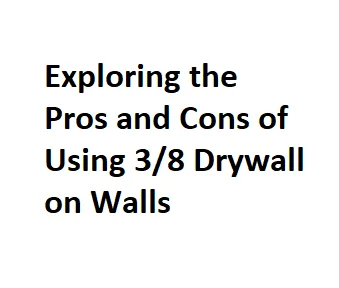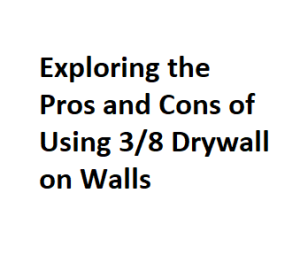When it comes to building or renovating your home, choosing the right materials is crucial for both aesthetics and structural integrity. Drywall, also known as gypsum board or plasterboard, is a popular choice for interior walls due to its versatility and ease of installation. However, the thickness of the drywall can impact its performance. In this blog post, we’ll delve into the question: Can I use 3/8 drywall on walls? We’ll explore the pros and cons to help you make an informed decision for your project.
Pros of Using 3/8 Drywall:
- Lightweight:
- One of the primary advantages of 3/8 drywall is its lightweight nature. This makes it easier to handle during installation, reducing the physical strain on builders and DIY enthusiasts alike.
- Flexibility:
- 3/8 drywall is more flexible than thicker options, making it a suitable choice for curved walls or areas that require bending. This flexibility can be advantageous in creative or unconventional designs.
- Cost-Effective:
- Thinner drywall is often less expensive than thicker alternatives. If you’re on a budget, using 3/8 drywall can be a cost-effective solution for your wall construction needs.
Cons of Using 3/8 Drywall:
- Reduced Sound Insulation:
- Thinner drywall tends to offer less sound insulation compared to thicker options. If soundproofing is a significant consideration for your space, you may need to explore other thicknesses or consider additional soundproofing measures.
- Lower Fire Resistance:
- Thicker drywall typically provides better fire resistance. While 3/8 drywall still meets basic fire safety standards, if you’re looking for enhanced fire protection, you might want to opt for a thicker option.
- Less Impact Resistance:
- Thicker drywall is generally more resistant to impacts and dents. If the walls are in an area prone to wear and tear or potential impact, you might want to consider a thicker drywall for added durability.
- Limited Use in Ceiling Applications:
- Thinner drywall might not be suitable for all applications, especially ceilings. Thicker drywall is often recommended for ceilings due to its increased strength and ability to resist sagging over time.
Tips for Working with 3/8 Drywall:
- Proper Installation Techniques:
- When working with 3/8 drywall, it’s crucial to follow proper installation techniques. Ensure that the drywall is securely fastened to the studs, and seams are properly taped and mudded to create a smooth surface.
- Consider Additional Support:
- If your walls require additional support due to factors like heavy fixtures or potential impact, consider adding extra studs or support structures behind the drywall. This can help compensate for the reduced thickness.
- Addressing Sound Insulation Concerns:
- If sound insulation is a priority, explore other solutions such as using acoustic insulation materials within the wall cavity or adding an extra layer of drywall with soundproofing properties.
- Fire Safety Measures:
- While 3/8 drywall meets basic fire safety standards, consider incorporating other fire-resistant materials or coatings for enhanced protection, especially in areas where fire safety is a significant concern.
- Blend with Thicker Drywall:
- In some cases, a combination of thicker and thinner drywall may be a suitable compromise. Use 3/8 drywall in areas where flexibility and cost are priorities, and opt for thicker drywall in spaces where increased durability and performance are essential.
- Regular Maintenance and Inspection:
- Periodically inspect the walls for any signs of damage or wear, especially in areas with a higher risk of impact. Performing regular maintenance can help address issues before they become more significant problems.


